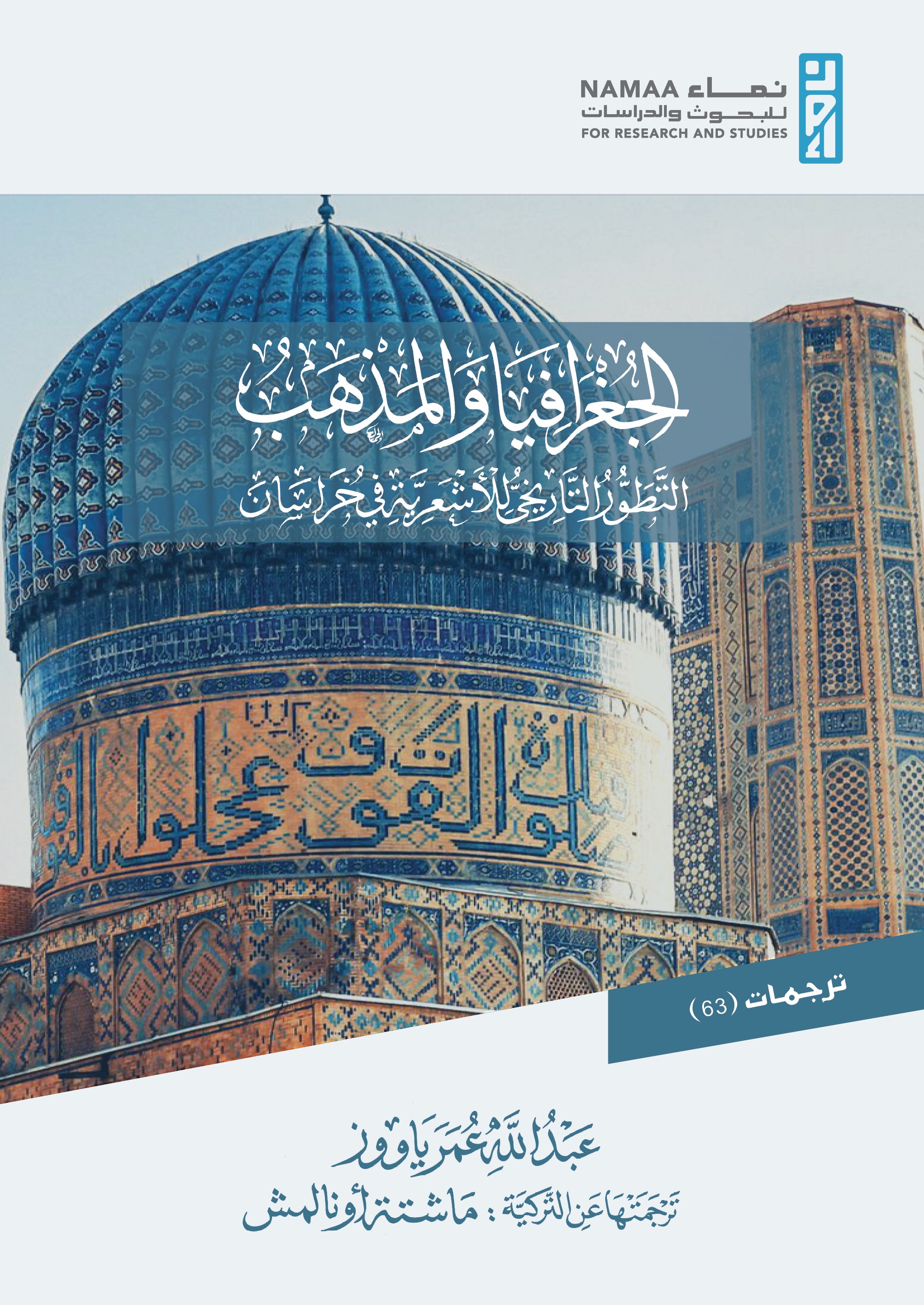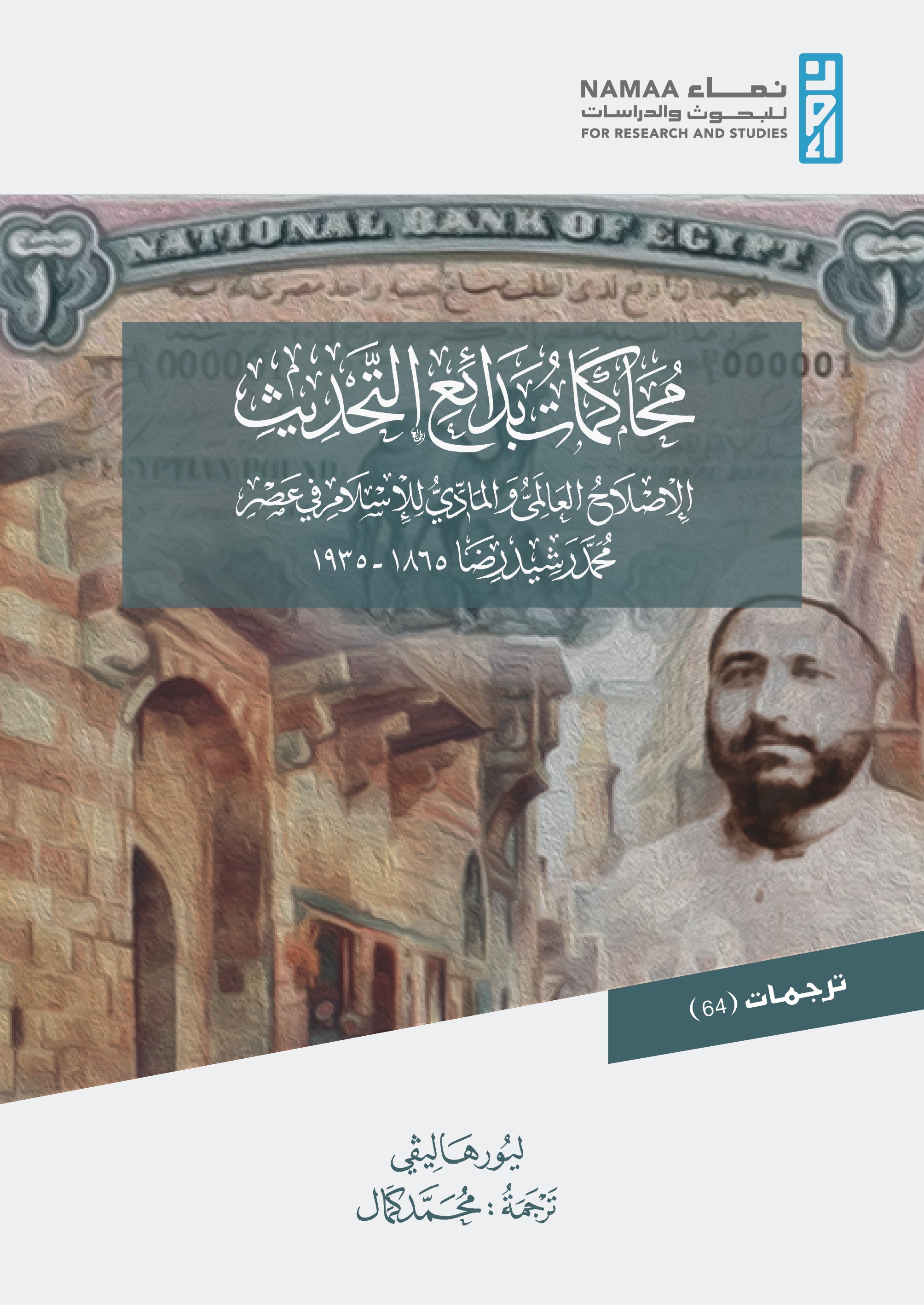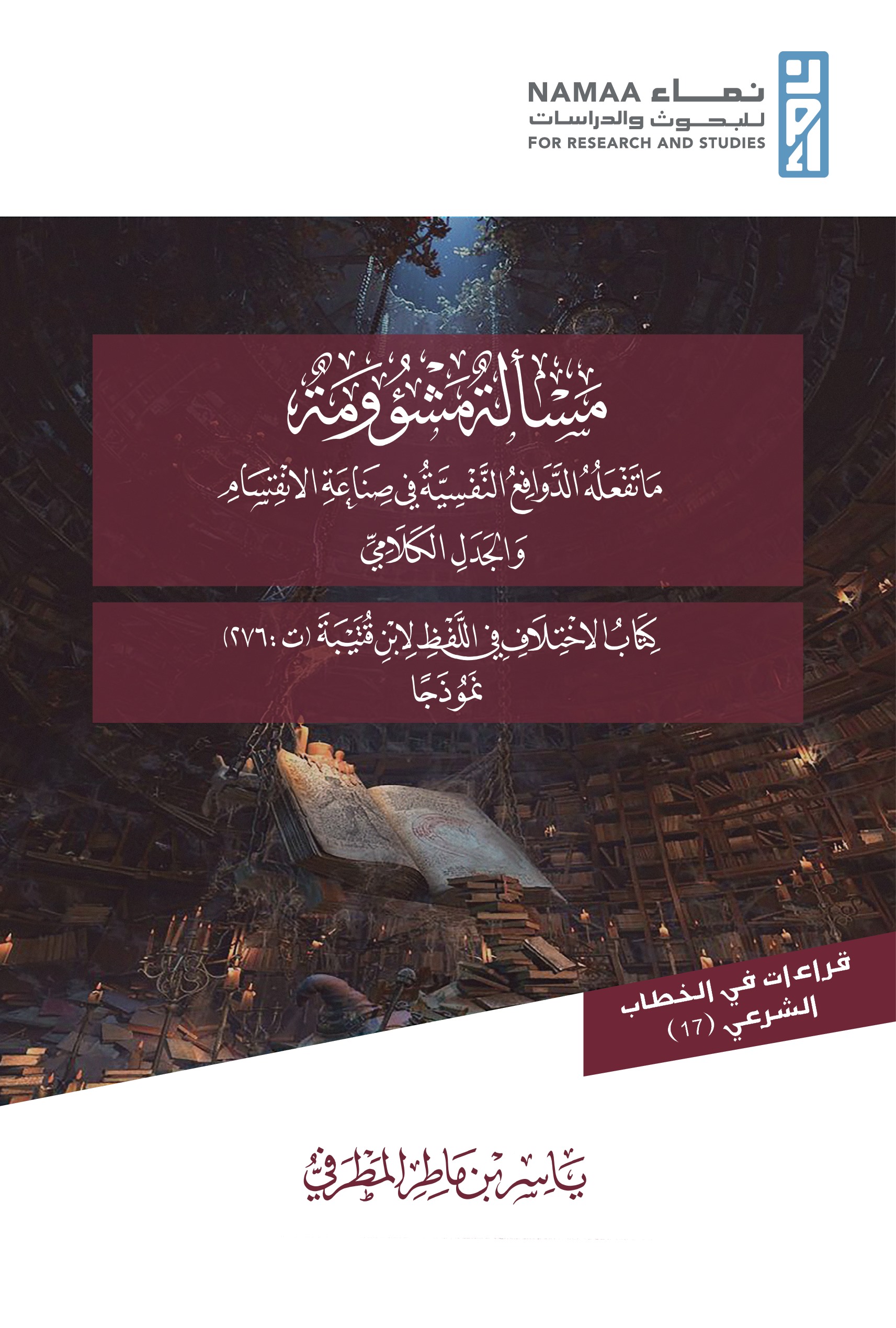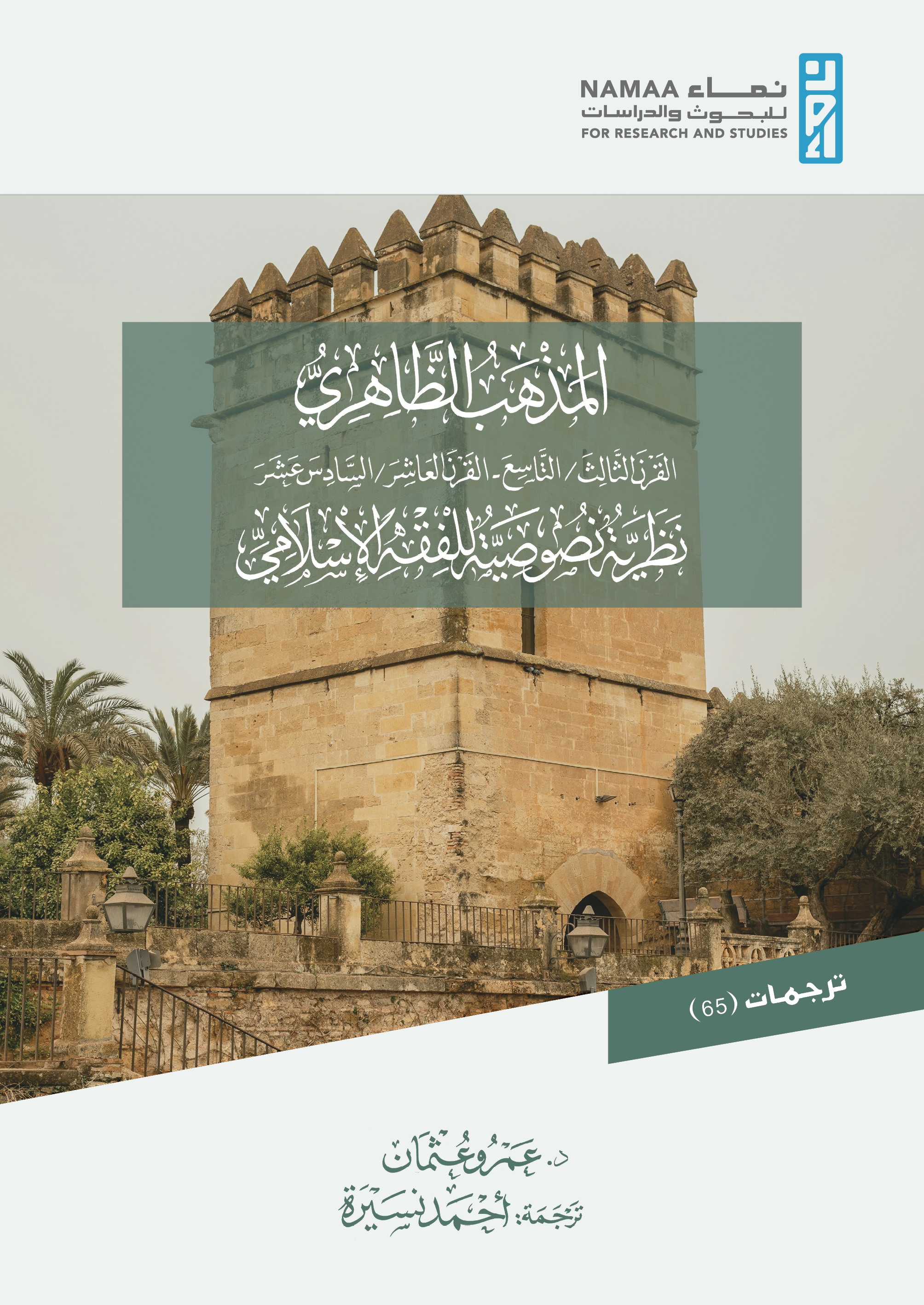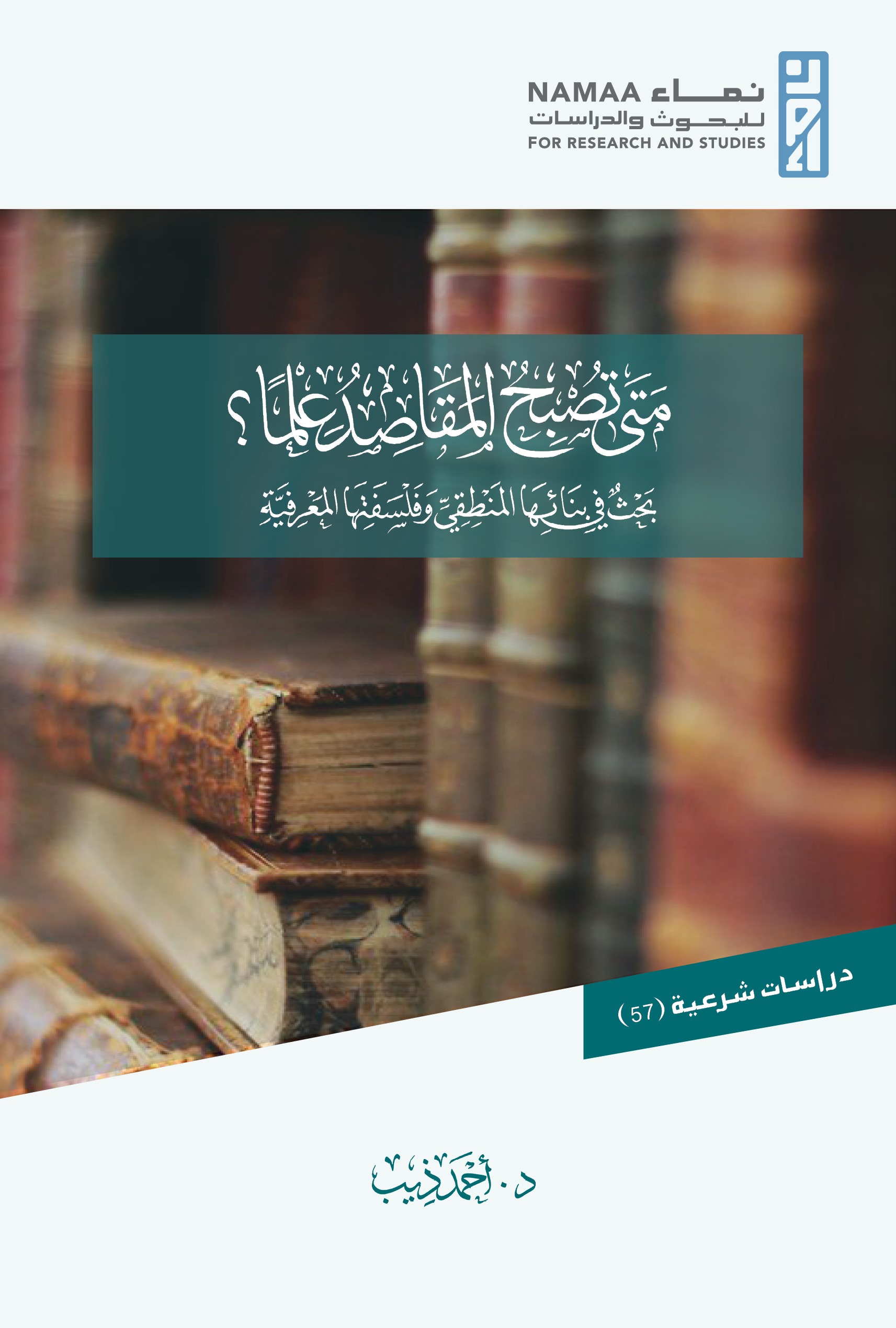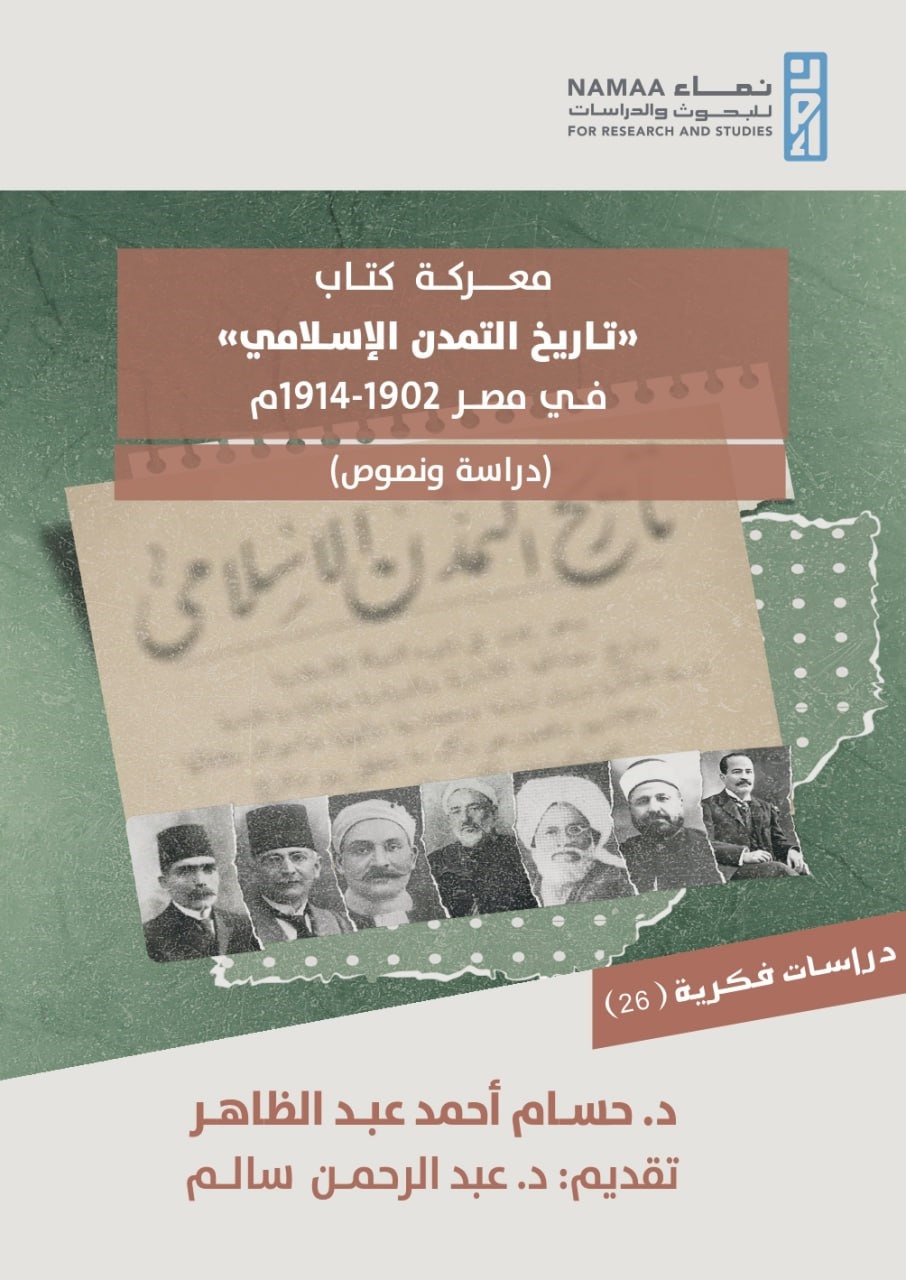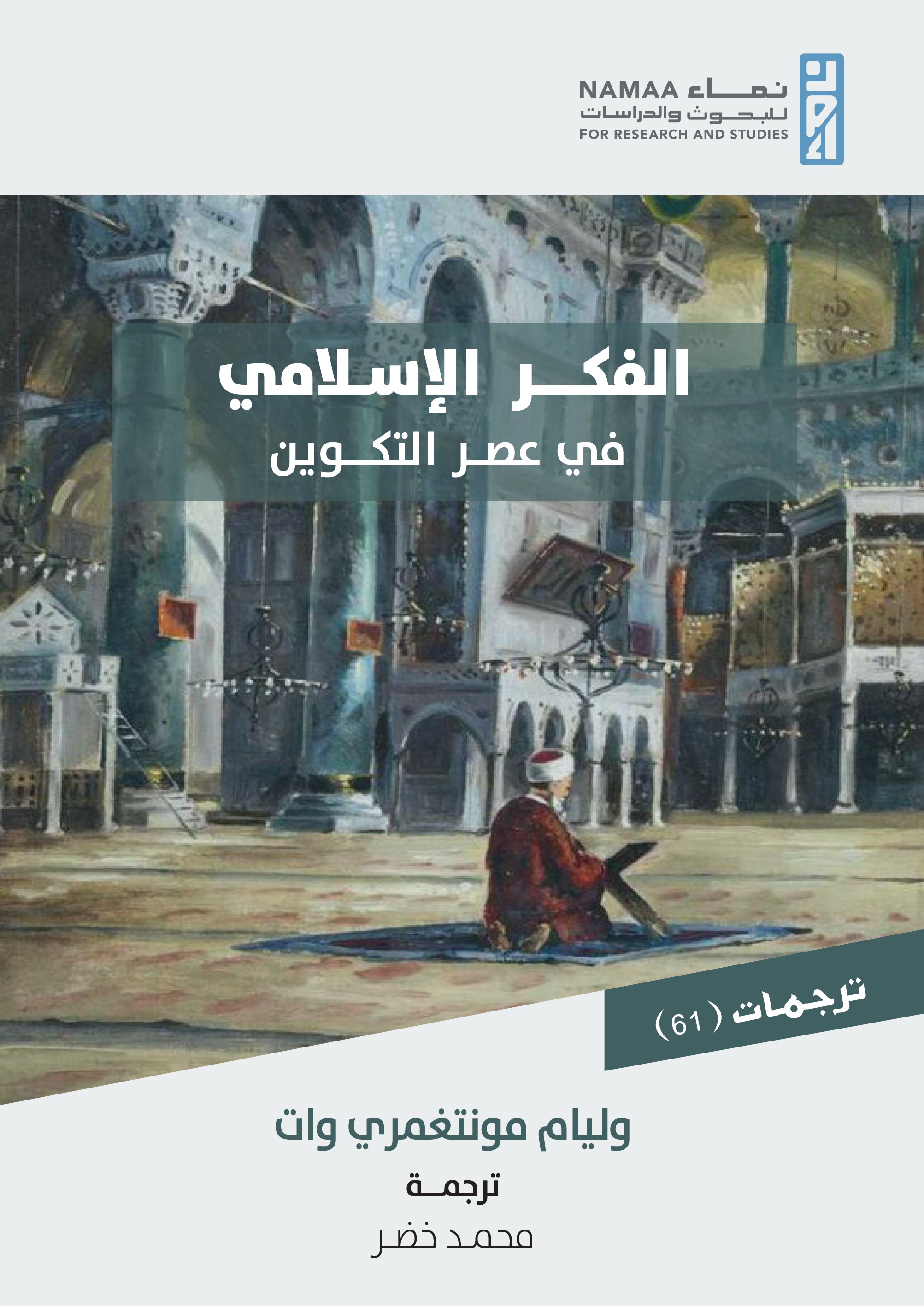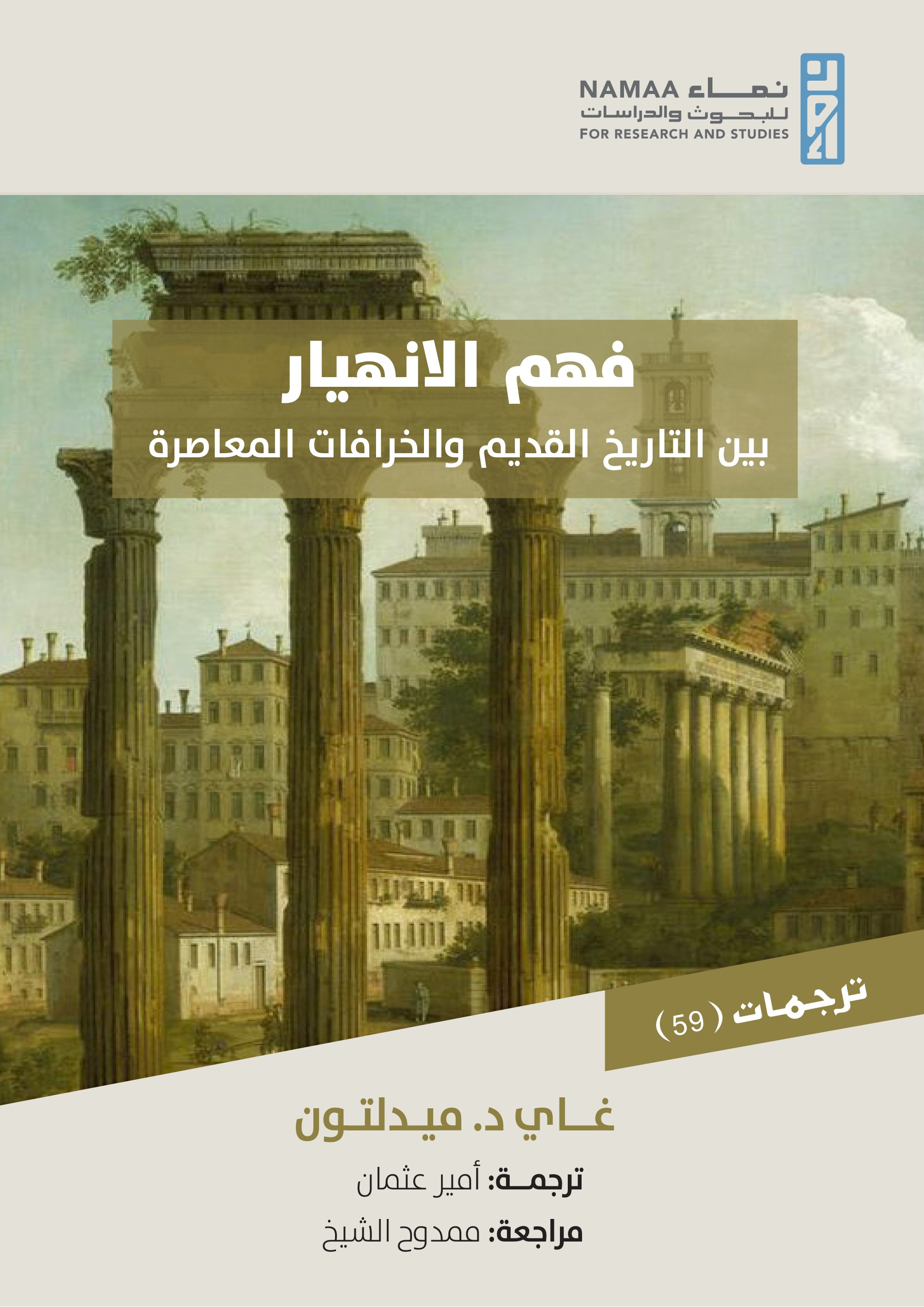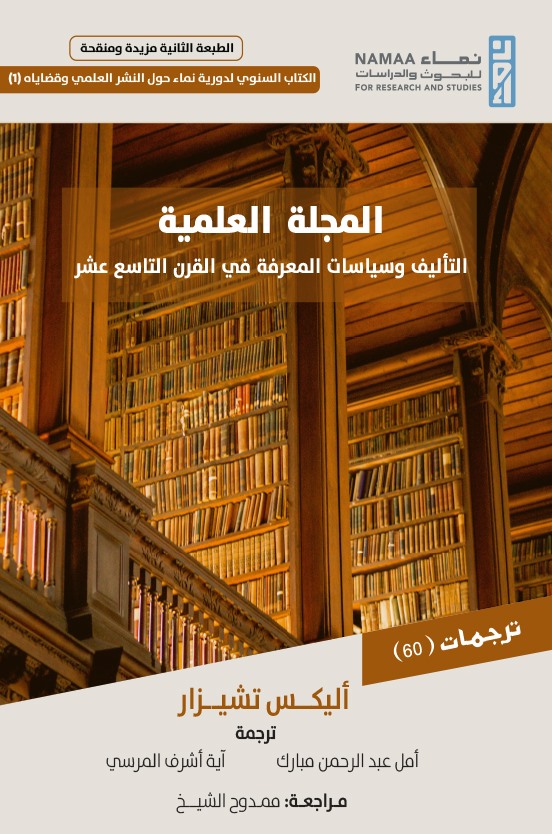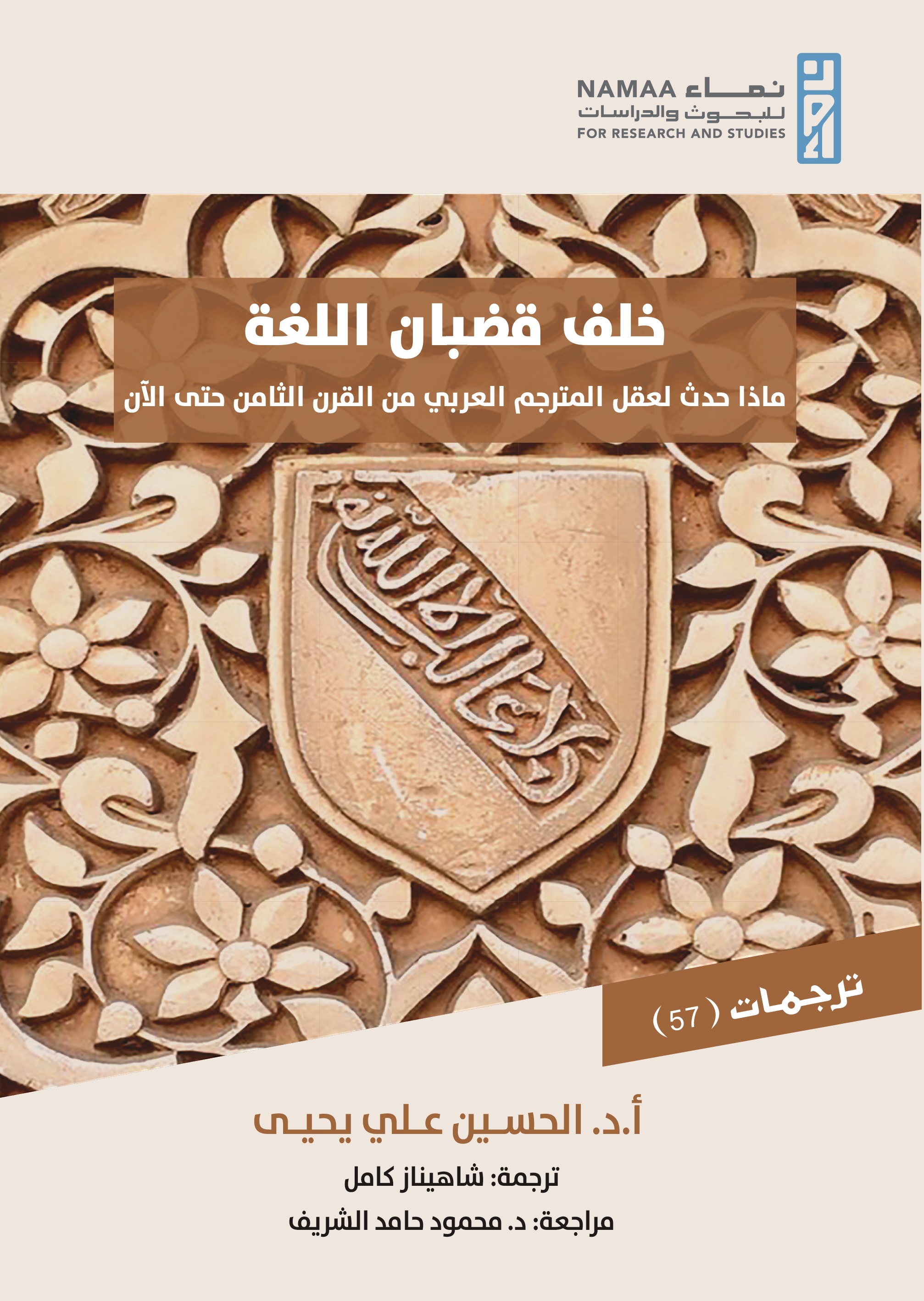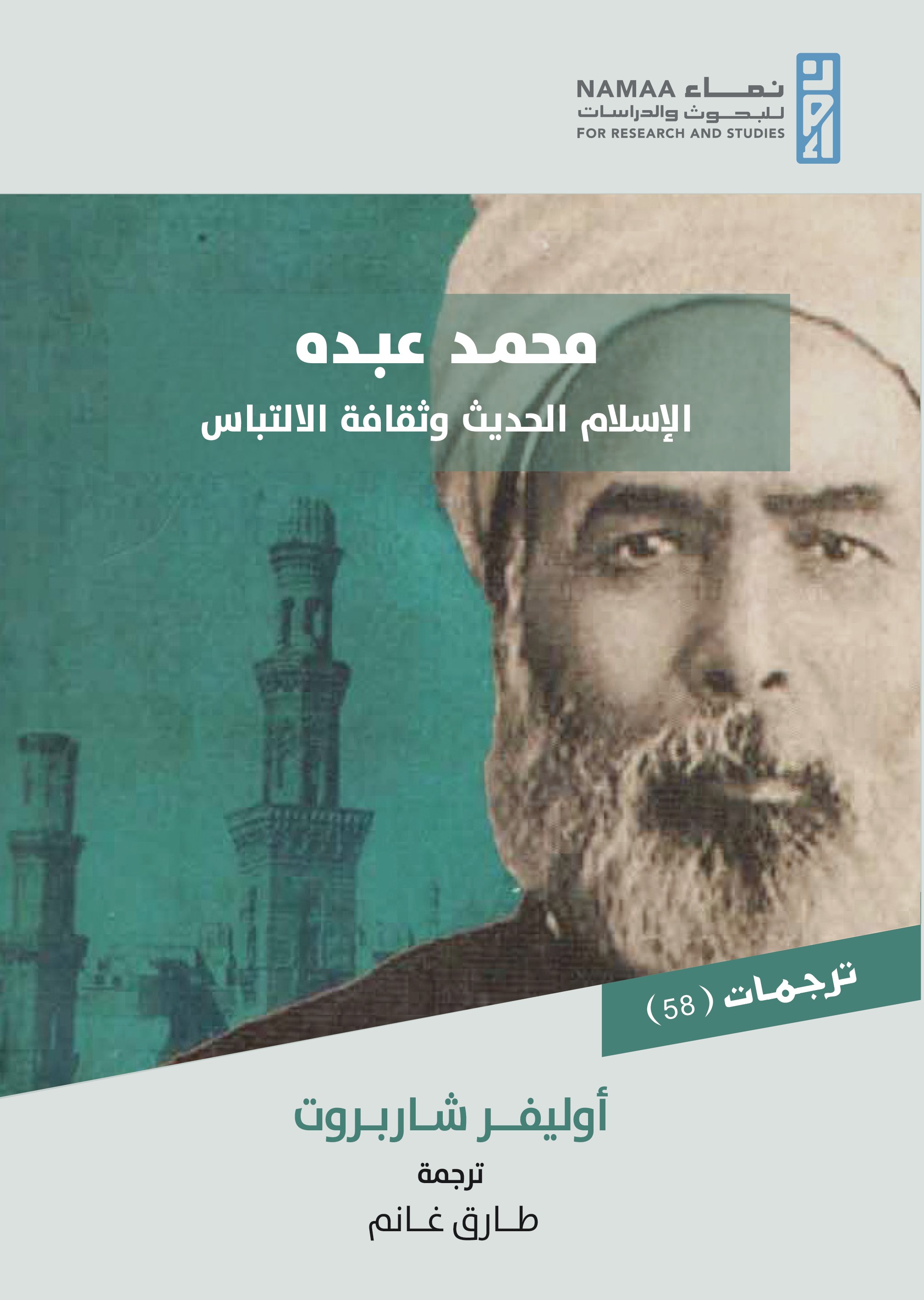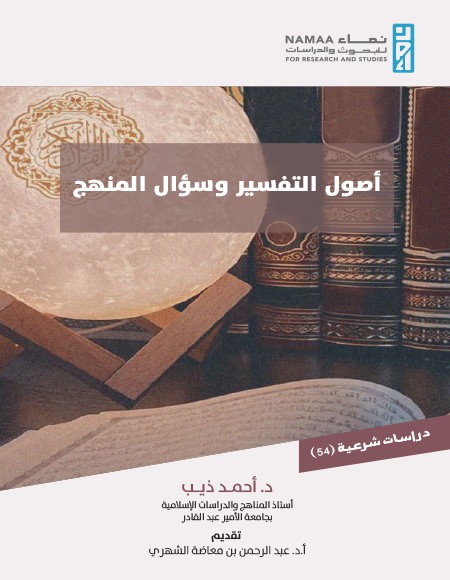{{vm.title}}
التفاصيل
جديد المركز
<p>لأن مذاهب الفكر الإسلامي لم تتخذ هيكلًا ثابتًا ومستقرًّا، بل مرت بعملية في غاية النشاط والسرعة، وشهدت الفترة الممتدة بين القرنين الرابع والسادس الهجريين أوج نشاط حركة الفكر الإسلامي، حيث إنها الفترة التي نشأت وتطورت فيها العلاقات الإيجابية أو السلبية بين المذاهب؛ وعليه فإنها فترة محورية بالنسبة للعديد من المذاهب. </p><p>وتعد جغرافية خراسان التي تقع فيها مدن نيسابور، ومرو، وهراة، وبلخ من أبرز حواضر الفكر الإسلامي الذي احتضنت هذه المذاهب. تبحث هذه الدراسة وجود مذهب الأشاعرة وتطوره في هذا السياق الجغرافي والزمني.</p>
<p class="MsoNormal" dir="RTL" style="margin-bottom:0cm;text-align:justify; text-indent:36.0pt;line-height:90%;direction:rtl;unicode-bidi:embed"><span lang="AR-EG" style="font-size:16.0pt;line-height:90%;font-family:"KFGQPC Uthman Taha Naskh"; mso-ascii-font-family:"Al Tarikh";mso-hansi-font-family:"Al Tarikh";mso-bidi-language: AR-EG">لأن الحداثة قد اصطدمت بالحالة الفقهية التقليدية فأنتجت تساؤلات وأثارت نقاشات عديدة، في التعامل مع منتجات الحداثة وما يقبع خلفها من فلسفات ورؤى، وما ينتج عنها من تغييرات في بنى المجتمع العلمي للفقهاء وعلماء الدين.<o:p></o:p></span></p><p class="MsoNormal" dir="RTL" style="margin-bottom:0cm;text-align:justify; text-indent:36.0pt;line-height:90%;direction:rtl;unicode-bidi:embed"><span lang="AR-EG" style="font-size:16.0pt;line-height:90%;font-family:"KFGQPC Uthman Taha Naskh"; mso-ascii-font-family:"Al Tarikh";mso-hansi-font-family:"Al Tarikh";mso-bidi-language: AR-EG">يستكشف كتاب «محاكمات بدائع التحديث» الممارسات الفقهية الإسلامية في أواخر القرن التاسع عشر وأوائل القرن العشرين عبر تحليل عدد مختار من الفتاوى، أصدر هذه الفتاوى محمد رشيد رضا، وهو شيخ شامي هاجر إلى مصر يُعد واحدًا من أهم الإصلاحيين المسلمين ذوي المعرفة التراثية في ذلك الوقت.<o:p></o:p></span></p><p class="MsoNormal" dir="RTL" style="margin-bottom:0cm;text-align:justify; text-indent:36.0pt;line-height:90%;direction:rtl;unicode-bidi:embed"><span lang="AR-EG" style="font-size:16.0pt;line-height:90%;font-family:"KFGQPC Uthman Taha Naskh"; mso-ascii-font-family:"Al Tarikh";mso-hansi-font-family:"Al Tarikh";mso-bidi-language: AR-EG">يقول أنصار رضا إنه واصل الإصلاح من خلال الفتاوى، في حين يرى منتقدوه أن عمله كان معرقلًا للإصلاح، ويهدف هاليفي إلى سبر كيفية صياغة قلم رضا وأنشطته السياسية للإصلاح العالمي والمادي للإسلام، بيد أن شخصية رضا يُنظر إليها عادة على أنها جزء من التوجه السلفي المعتدل في الإسلام الحديث.<o:p></o:p></span></p><p> <span lang="AR-EG" dir="RTL" style="font-size:16.0pt;line-height:107%;font-family: "KFGQPC Uthman Taha Naskh";mso-ascii-font-family:"Al Tarikh";mso-fareast-font-family: Calibri;mso-fareast-theme-font:minor-latin;mso-hansi-font-family:"Al Tarikh"; mso-ansi-language:EN-US;mso-fareast-language:EN-US;mso-bidi-language:AR-EG">يواصل العلماء والباحثون كشف الأسباب المعقدة وراء الخطابات الدينية المعروفة بالإصلاح الإسلامي الحديث، إذ أصبحت المناقشات الاستقطابية لغزًا في هذا المجال العلمي، فيرى بعض الباحثين أن الإسلام لديه ميل ذاتي للتكيف مع الإيمان السماوي، بشرط أن يتولى علماء حقيقيون وورعون مهمة التغيير، ويرى آخرون أن الإصلاح الإسلامي ليس أكثر من استسلام للحداثة الاستعمارية أو خضوع لمكائد قوى الهيمنة الإمبريالية، ويرون ذلك مغامرة وخيمة العواقب. لا يدخل هاليفي إلى هذه المنطقة الملغمة، لكن بعض جدله يدور حول فتاوى رضا المتعلقة بالمخترعات الحديثة (بدائع التحديث).</span><br></p>
<p class="MsoNormal" dir="RTL" style="text-align:justify;text-indent:36.95pt; direction:rtl;unicode-bidi:embed"><span lang="AR-SA" style="font-size:14.0pt; mso-ansi-font-size:16.0pt;line-height:107%;font-family:"louts shamy"">لأن مسألة اللفظ كانت مسألة مشؤومة على أهل الحديث، أثارت بينهم كثيرًا من النزاع، واختلاف الرؤى الذي يصل إلى حد التبديع والتكفير، وكانت مقاربة ابن قتيبة لهذه الاختلافات مقاربة تحليلية بديعة، تكشف عن الكامن في النفوس خلف الشقاق والاحتراب، وتبين عن أسباب النزاع، وتحاول أن تصل بأهل الحديث في هذه المسألة الشائكة إلى سواء السبيل، وتوقف ما بينهم من صراع حولها.<o:p></o:p></span></p><p> </p><p class="MsoNormal" dir="RTL" style="text-align:justify;text-indent:36.95pt; direction:rtl;unicode-bidi:embed"><span lang="AR-SA" style="font-size:14.0pt; mso-ansi-font-size:16.0pt;line-height:107%;font-family:"louts shamy"">حاولت هذه الدراسة أن تقدم مقاربة أخرى تضاف إلى المقاربات المتداولة في التعامل مع الاختلافات الكلامية، وهي المقاربة النفسية، ولفتت النظر إلى أهمية كتاب (الاختلاف في مسألة اللفظ)، باعتباره وثيقة تاريخية مبكرة في تفسير الخلافات الكلامية التي حدثت بين أهل الحديث في القرن الثالث الهجري، كما كشفت عن مركزية تأثير الدوافع النفسية باعتبارها مدخلًا أساسيًّا لفهم هذا الكتاب، ودللت على أن التحيزات النفسية هي التي اعتمد عليها ابن قتيبة في تفسير ظاهرة الانقسام والتكفير التي وقعت بين أهل الحديث حول مسألة اللفظ</span><span dir="LTR"></span><span dir="LTR"></span><span dir="LTR" style="font-size:14.0pt; line-height:107%;font-family:BahijLotus;mso-ascii-font-family:BahijLotus"><span dir="LTR"></span><span dir="LTR"></span>.</span><span lang="AR-EG" style="font-size: 14.0pt;line-height:107%;font-family:"KFGQPC Uthman Taha Naskh";mso-ascii-font-family: "Al Tarikh";mso-hansi-font-family:"Al Tarikh";mso-bidi-language:AR-EG"><o:p></o:p></span></p>
<p class="MsoNormal" dir="RTL" style="margin-bottom:0cm;text-align:justify; text-indent:36.0pt;line-height:90%;direction:rtl;unicode-bidi:embed"><span lang="AR-EG" style="font-size:16.0pt;line-height:90%;font-family:"KFGQPC Uthman Taha Naskh"; mso-ascii-font-family:"Al Tarikh";mso-hansi-font-family:"Al Tarikh";mso-bidi-language: AR-EG">يقدم هذا الكتاب قراءة جديدة لتاريخ المذهب الظاهري وأصول فقهه، فيتتبع الكتاب نشأة المذهب وانتشاره في أقطار العالم الإسلامي في قرون الإسلام الوسيطة وصولًا إلى «اندثاره» بانقطاع الأخبار عن فقهاء منتسبين إليه.<o:p></o:p></span></p><p class="MsoNormal" dir="RTL" style="margin-bottom:0cm;text-align:justify; text-indent:36.0pt;line-height:90%;direction:rtl;unicode-bidi:embed"><span lang="AR-EG" style="font-size:16.0pt;line-height:90%;font-family:"KFGQPC Uthman Taha Naskh"; mso-ascii-font-family:"Al Tarikh";mso-hansi-font-family:"Al Tarikh";mso-bidi-language: AR-EG">ثم يتبنى الكتاب منهجًا استقرائيًّا لتعريف «الظاهر» الذي اقترن به اسم المذهب، ومنهجًا تحليليًّا في السعي لتعريف «الحَرْفِيَّة» التي لُصِقَتْ بالمذهب دون برهان.<o:p></o:p></span></p><p> </p><p class="MsoNormal" dir="RTL" style="margin-bottom:0cm;text-align:justify; text-indent:36.0pt;line-height:90%;direction:rtl;unicode-bidi:embed"><span lang="AR-EG" style="font-size:16.0pt;line-height:90%;font-family:"KFGQPC Uthman Taha Naskh"; mso-ascii-font-family:"Al Tarikh";mso-hansi-font-family:"Al Tarikh";mso-bidi-language: AR-EG">ثم يتبنى منهجًا مقارنًا يسعى إلى إعادة النظر في علاقة المذهب بتياري «أهل الرأي» و«أهل الحديث» في قرون الإسلام الأولى، وإلى البرهنة على كونه مذهبًا «نصوصيًّا» أشبه بتيار النصوصية المعروف في فلسفة تفسير الدستور والقانون في الولايات المتحدة الأمريكية. <o:p></o:p></span></p>
<p class="MsoNormal" dir="RTL" style="margin-bottom:0cm;text-align:justify; text-indent:36.0pt;line-height:90%;direction:rtl;unicode-bidi:embed"><span lang="AR-YE" style="font-size: 14pt; line-height: 90%; font-family: "KFGQPC Uthman Taha Naskh";">لأن المعرفة المقاصدية -باعتبارها حقلًا إبستمولوجيًّا- موصولة بعلم أصول الفقه، فهي تندرج ضمن مبحث مسالك العلّة، ولم تُدرس باعتبارها علمًا مستقلًّا إلا في العقود الأخيرة</span><span dir="LTR"></span><span dir="LTR"></span><span dir="LTR" style="font-size: 14pt; line-height: 90%; font-family: "Al Tarikh";"><span dir="LTR"></span><span dir="LTR"></span>.</span><span lang="AR-YE" style="font-size: 14pt; line-height: 90%; font-family: "KFGQPC Uthman Taha Naskh";"><o:p></o:p></span></p><p class="MsoNormal" dir="RTL" style="margin-bottom:0cm;text-align:justify; text-indent:36.0pt;line-height:90%;direction:rtl;unicode-bidi:embed"><span lang="AR-YE" style="font-size: 14pt; line-height: 90%; font-family: "KFGQPC Uthman Taha Naskh";">فمنذ أن اكتَشفَ النَّاسُ موافقات الشاطبي وإشاداته بهذا المبحث المهمّ تنامت الكتابات المَقاصدية، وكَثُرَ رُوَّادُهَا، وَتَنَاغَتْ وُعُودُهَا السَّخِيَّةِ</span><span dir="LTR"></span><span dir="LTR"></span><span dir="LTR" style="font-size: 14pt; line-height: 90%; font-family: "Al Tarikh";"><span dir="LTR"></span><span dir="LTR"></span>.</span><span lang="AR-YE" style="font-size: 14pt; line-height: 90%; font-family: "KFGQPC Uthman Taha Naskh";"><o:p></o:p></span></p><p class="MsoNormal" dir="RTL" style="margin-bottom:0cm;text-align:justify; text-indent:36.0pt;line-height:90%;direction:rtl;unicode-bidi:embed"><span lang="AR-YE" style="font-size: 14pt; line-height: 90%; font-family: "KFGQPC Uthman Taha Naskh";">غير أنَّ أغلب هذه الكتابات قنعت بالإشادة بجهود «الإمام» في إظهار القول بالمقاصد، وغفلت عمّا يتطلبه النّموذج الإرشادي الجديد، من نحت المصطلحات، وتحديد الموضوعات، واجتراح المناهج؛ الأمر الذي أدّى إلى تنامي الخلاف حول هذه النَّظرية، وظهور العديد من المشكلات المعرفية والمنهجيّة</span><span dir="LTR"></span><span dir="LTR"></span><span dir="LTR" style="font-size: 14pt; line-height: 90%; font-family: "Al Tarikh";"><span dir="LTR"></span><span dir="LTR"></span>. </span><span lang="AR-YE" style="font-size: 14pt; line-height: 90%; font-family: "KFGQPC Uthman Taha Naskh";"><o:p></o:p></span></p><p> </p><p class="MsoNormal" dir="RTL" style="margin-bottom:0cm;text-align:justify; text-indent:36.0pt;line-height:90%;direction:rtl;unicode-bidi:embed"><span lang="AR-YE" style="font-size: 14pt; line-height: 90%; font-family: "KFGQPC Uthman Taha Naskh";">وجليّ أنَّ تحديد مشكلة المعرفة المقاصدية أو منطق تخلّفها واضطرابها النسبيّ، يرجع أساسًا إلى عجزها عن بلوغ المرحلة التفسيريّة المنطقية.</span><span dir="LTR" style="font-size: 14pt; line-height: 90%; font-family: "Al Tarikh";"><o:p></o:p></span></p>
<p class="MsoNormal" dir="RTL" style="margin-bottom:0cm;text-align:justify; text-indent:36.0pt;line-height:90%;direction:rtl;unicode-bidi:embed"><span lang="AR-EG" style="font-size:14.0pt;line-height:90%;font-family:"KFGQPC Uthman Taha Naskh"; mso-ascii-font-family:"Al Tarikh";mso-hansi-font-family:"Al Tarikh";mso-bidi-language: AR-EG">لما تمثله المعارك الفكرية من أهمية كبيرة في تشكل الأفكار وتطورها، وتكثر هذه المعارك في فترات النهوض والأحداث المفصلية الكبرى، لما تمثله من بيئة خصبة لتخلق الأفكار الجديدة وإذكاء السجالات حولها.<o:p></o:p></span></p><p class="MsoNormal" dir="RTL" style="text-align:justify;text-indent:36.0pt; line-height:90%;direction:rtl;unicode-bidi:embed"><span lang="AR-EG" style="font-size:14.0pt;line-height:90%;font-family:"KFGQPC Uthman Taha Naskh"; mso-ascii-font-family:"Al Tarikh";mso-hansi-font-family:"Al Tarikh";mso-bidi-language: AR-EG">يناقش هذا الكتاب معركة فكرية دارت حول كتاب «تاريخ التمدن الإسلامي» لمؤلفه جرجي زيدان (1861-1914م). وهي معركة فكرية دارت وقائعها خلال الفترة (1902-1914م)، وقد تكاثرت الردود والنقاشات حول الكتاب إبَّان صدوره، إلا أن أكثرها طَوَتْه يد النسيان؛ لأنها </span><span lang="AR-SA" style="font-size:14.0pt; line-height:90%;font-family:"KFGQPC Uthman Taha Naskh";mso-ascii-font-family: "Al Tarikh";mso-hansi-font-family:"Al Tarikh"">متناثرة في بطون الدوريات القديمة، وهو الأمر الذي جعل من المتعذر على الكثيرين الاطلاع عليها ومعرفة مضامينها.</span><span lang="AR-EG" style="font-size:14.0pt;line-height:90%; font-family:"KFGQPC Uthman Taha Naskh";mso-ascii-font-family:"Al Tarikh"; mso-hansi-font-family:"Al Tarikh";mso-bidi-language:AR-EG"><o:p></o:p></span></p><p class="MsoNormal" dir="RTL" style="text-align:justify;text-indent:36.0pt; line-height:90%;direction:rtl;unicode-bidi:embed"><span lang="AR-SA" style="font-size:14.0pt;line-height:90%;font-family:"KFGQPC Uthman Taha Naskh"; mso-ascii-font-family:"Al Tarikh";mso-hansi-font-family:"Al Tarikh"">وكان للنظرة المتربصة لهذا الكتاب في كتابات كثيرة الدافع الأكبر لتقصي حوادث هذه المعركة الفكرية وأجوائها التاريخية في حياة مؤلف الكتاب، بهدف البحث عن أسبابها ومتابعة تطوراتها والوقوف على نتائجها</span><span dir="LTR"></span><span dir="LTR"></span><span dir="LTR" style="font-size:14.0pt;line-height:90%;font-family:"Al Tarikh"; mso-bidi-font-family:"KFGQPC Uthman Taha Naskh""><span dir="LTR"></span><span dir="LTR"></span>.</span><span lang="AR-SA" style="font-size:14.0pt;line-height: 90%;font-family:"KFGQPC Uthman Taha Naskh";mso-ascii-font-family:"Al Tarikh"; mso-hansi-font-family:"Al Tarikh""><o:p></o:p></span></p><p> </p><p class="MsoNormal" dir="RTL" style="text-align:justify;text-indent:36.0pt; line-height:90%;direction:rtl;unicode-bidi:embed"><span lang="AR-SA" style="font-size:14.0pt;line-height:90%;font-family:"KFGQPC Uthman Taha Naskh"; mso-ascii-font-family:"Al Tarikh";mso-hansi-font-family:"Al Tarikh"">وكان أفضل سبيل إلى ذلك هو إتاحة نصوص هذه المعركة كاملة أمام الباحثين والدارسين والقراء، مع تقديم محاولة دراسية أولى لهذه النصوص، وهو الهدف الأول من هذا الكتاب.</span><span dir="LTR" style="font-size:14.0pt;line-height:90%;font-family:"Al Tarikh"; mso-bidi-font-family:"KFGQPC Uthman Taha Naskh";mso-bidi-language:AR-EG"><o:p></o:p></span></p>
<p class="MsoNormal" dir="RTL" style="margin-bottom:0cm;text-align:justify; text-indent:36.0pt;line-height:90%;direction:rtl;unicode-bidi:embed"><span lang="AR-EG" style="font-size:14.0pt;line-height:90%;font-family:"KFGQPC Uthman Taha Naskh"; mso-ascii-font-family:"Al Tarikh";mso-hansi-font-family:"Al Tarikh";mso-bidi-language: AR-EG">لأن حقبة تشكل الفكر الإسلامي لا تزال بحاجة إلى مزيد من إلقاء الضوء عليها لتبين الخلفيات الفكرية والتاريخية والاجتماعية للفرق والمذاهب الإسلامية، ولأن حقبة التشكل تخضع لصراع التأويلات وتتجاذبها مختلف الأيديولوجيات، إذ إنها -إيجابًا وسلبًا- تمثِّل أصولًا لشرعنة الفرق والمذاهب المتصارعة لنفسها، وشيطنة مخالفيها، ولا يمكن فهم حال الفكر الإسلامي في صيروراته المختلفة إلا بالنظر إلى ما كان عليه إبان النشأة.<o:p></o:p></span></p><p class="MsoNormal" dir="RTL" style="margin-bottom:0cm;text-align:justify; text-indent:36.0pt;line-height:90%;direction:rtl;unicode-bidi:embed"><span lang="AR-EG" style="font-size:14.0pt;line-height:90%;font-family:"KFGQPC Uthman Taha Naskh"; mso-ascii-font-family:"Al Tarikh";mso-hansi-font-family:"Al Tarikh";mso-bidi-language: AR-EG">ينقسم الكتاب إلى ثلاثة أجزاء؛ الأول: «البدايات»، ويلقي فيه وات الضوء على تشكُّل الخوارج وأثرهم المغفول عنه في إذْكاء الجدالات الكلامية، ثم يحلل الخلافات السياسية التي كانت مهادًا لحركات التشيع، ويبحث سؤال القدر وكيف تشكَّل السجال فيه في هذا الزمان، ثم يبحث مشكلة الإرجاء بين المعتزلة والجهمية والفقهاء، وكيف استعمل علماء المقالات مصطلح «المرجئة».<o:p></o:p></span></p><p class="MsoNormal" dir="RTL" style="margin-bottom:0cm;text-align:justify; text-indent:36.0pt;line-height:90%;direction:rtl;unicode-bidi:embed"><span lang="AR-EG" style="font-size:14.0pt;line-height:90%;font-family:"KFGQPC Uthman Taha Naskh"; mso-ascii-font-family:"Al Tarikh";mso-hansi-font-family:"Al Tarikh";mso-bidi-language: AR-EG">في الجزء الثاني يبحث نشأة الدولة العباسية، وما أحدثه من أسئلةٍ جديدة وإن كانت قديمة تفرعت عنها جدالات فقهية وكلامية، وكيف أسهم المأمون وعصره في تشكل آراء الفلاسفة والمتكلمين، وتطور الاعتزال وتشققه إلى مدارس متصارعة.<o:p></o:p></span></p><p> </p><p class="MsoNormal" dir="RTL" style="margin-bottom:0cm;text-align:justify; text-indent:36.0pt;line-height:90%;direction:rtl;unicode-bidi:embed"><span lang="AR-EG" style="font-size:14.0pt;line-height:90%;font-family:"KFGQPC Uthman Taha Naskh"; mso-ascii-font-family:"Al Tarikh";mso-hansi-font-family:"Al Tarikh";mso-bidi-language: AR-EG">وفي الجزء الثالث يبحث نشأة مذهبٍ كلامي سني، واستقرار الفرق الكلامية بعد تشذيب الخلافات وتشكل هوية لكل فرقة على حِدَةٍ، مبينًا أهمية إنجاز أبي الحسن الأشعري في مفارقة الاعتزال وتخليق مذهبه الجديد إذ ذاك.<o:p></o:p></span></p>
<p class="MsoNormal" dir="RTL" style="margin-bottom:0cm;text-align:justify; text-indent:36.0pt;line-height:90%;direction:rtl;unicode-bidi:embed"><span lang="AR-EG" style="font-size:14.0pt;line-height:90%;font-family:"KFGQPC Uthman Taha Naskh"; mso-ascii-font-family:"Al Tarikh";mso-hansi-font-family:"Al Tarikh";mso-bidi-language: AR-EG">يستكشف «فهم الانهيار» انهيار الحضارات القديمة، كالإمبراطورية الرومانية، والمايا، وجزيرة عيد الفصح. وفي هذه الدراسة الاستقصائية المُفعمة بالحيوية، يختبر غاي د. ميدلتون بعين الناقد أفكارنا بشأن الانهيار</span><span lang="AR-EG" style="font-size:14.0pt;line-height:90%;font-family:"Sakkal Majalla"; mso-bidi-language:AR-EG"> –</span><span lang="AR-EG" style="font-size:14.0pt; line-height:90%;font-family:"KFGQPC Uthman Taha Naskh";mso-ascii-font-family: "Al Tarikh";mso-hansi-font-family:"Al Tarikh";mso-bidi-language:AR-EG">كيف نفسره وكيف أقمنا خرافات حول الانهيارات من المُحتمَل أن تكون مُضلِّلة</span><span lang="AR-EG" style="font-size:14.0pt;line-height:90%;font-family:"Sakkal Majalla"; mso-bidi-language:AR-EG">–</span><span lang="AR-EG" style="font-size:14.0pt; line-height:90%;font-family:"KFGQPC Uthman Taha Naskh";mso-ascii-font-family: "Al Tarikh";mso-hansi-font-family:"Al Tarikh";mso-bidi-language:AR-EG">، ويُظهِر المؤلف كيف ولماذا تكون ظاهرة انهيار المجتمعات أعقد بكثير مما يُسلَّم به في الغالب. وبدلًا من طرح نموذجٍ تفسيري وحيد للانهيار</span><span lang="AR-EG" style="font-size:14.0pt;line-height:90%;font-family:"Sakkal Majalla"; mso-bidi-language:AR-EG"> –</span><span lang="AR-EG" style="font-size:14.0pt; line-height:90%;font-family:"KFGQPC Uthman Taha Naskh";mso-ascii-font-family: "Al Tarikh";mso-hansi-font-family:"Al Tarikh";mso-bidi-language:AR-EG">ذي بُعْدٍ اقتصادي، أو اجتماعي، أو بيئي</span><span lang="AR-EG" style="font-size:14.0pt; line-height:90%;font-family:"Sakkal Majalla";mso-bidi-language:AR-EG">–</span><span lang="AR-EG" style="font-size:14.0pt;line-height:90%;font-family:"KFGQPC Uthman Taha Naskh"; mso-ascii-font-family:"Al Tarikh";mso-hansi-font-family:"Al Tarikh";mso-bidi-language: AR-EG"> يأخذ ميدلتون بعين الاعتبار المرونة الموجودة في مجتمعات الشعوب القديمة، وهي الخاصية التي يتم تجاهلها تمامًا كما يتم تجاهُل الخيارات التي قاموا بها. ويعرض تفسيرًا جديدًا سهل المنال بالنسبة للطلبة وللعلماء على حدٍ سواء.</span><span dir="LTR" style="font-size:14.0pt;line-height:90%;font-family:"Al Tarikh";mso-bidi-font-family: "KFGQPC Uthman Taha Naskh";mso-bidi-language:AR-EG"><o:p></o:p></span></p>
<p class="MsoNormal" dir="RTL" style="margin-bottom:0cm;text-align:justify; text-indent:36.0pt;line-height:90%;direction:rtl;unicode-bidi:embed"><span lang="AR-EG" style="font-size: 14pt; line-height: 90%; font-family: "KFGQPC Uthman Taha Naskh";">لأن المجلات العلمية كانت ولا تزال محضنًا لتشكل الرؤى والأفكار العلمية، وصقلها بالنقد وآراء الخبراء، وهو ما كان له دور كبير في بنية الفكر الأوروبي في القرن التاسع عشر، بما له من أهمية في تاريخ الأفكار والعلوم.<o:p></o:p></span></p><p class="MsoNormal" dir="RTL" style="margin-bottom:0cm;text-align:justify; text-indent:36.0pt;line-height:90%;direction:rtl;unicode-bidi:embed"><span lang="AR-YE" style="font-size: 14pt; line-height: 90%; font-family: "KFGQPC Uthman Taha Naskh";">يتتبع هذا الكتاب صعود المجلات العلمية الحديثة في أوروبا الغربية، مع التركيز على العلاقة المتغيرة بين التأليف والهوية العلمية، والتحولات في أنظمة الحكم، وتطوير مفاهيم الثقة والمساءلة العامة. وهو أول كتاب يحاول شرح كيفية كان تكوين الباحثين في العالم الطبيعي، بحلول أوائل القرن العشرين.</span><span lang="AR-SA" style="font-size:14.0pt; line-height:90%;font-family:"KFGQPC Uthman Taha Naskh";mso-ascii-font-family: "Al Tarikh";mso-hansi-font-family:"Al Tarikh""><o:p></o:p></span></p><p> </p><p class="MsoNormal" dir="RTL" style="margin-bottom:0cm;text-align:justify; text-indent:36.0pt;line-height:90%;direction:rtl;unicode-bidi:embed"><span lang="AR-YE" style="font-size: 14pt; line-height: 90%; font-family: "KFGQPC Uthman Taha Naskh";">كما يبحث كيف تطورت الأشكال والأنواع، للصحف والمجلات والكتب وقواعد البيانات، بالاقتران مع التغييرات في كيفية معرفة العلماء والدارسين عن العالم الطبيعي، وفي المعايير التي يستخدمونها للثقة في ادِّعاءات المعرفة للآخرين.</span><span lang="AR-YE" style="font-size: 14.0pt;line-height:90%;font-family:"KFGQPC Uthman Taha Naskh";mso-ascii-font-family: "Al Tarikh";mso-hansi-font-family:"Al Tarikh";mso-bidi-language:AR-YE"><o:p></o:p></span></p>
<p class="MsoNormal" dir="RTL" style="margin-bottom:0cm;text-align:justify; text-indent:36.0pt;line-height:90%;direction:rtl;unicode-bidi:embed"><span lang="AR-SA" style="font-size:14.0pt;line-height:90%;font-family:"KFGQPC Uthman Taha Naskh"; mso-ascii-font-family:"Al Tarikh";mso-hansi-font-family:"Al Tarikh"">لأن الترجـمة رحلة بين ثقافتين ولغتين وعقلين عقل، تبحر فيها الحروف حاملة المعاني على ظهرها. في «خلف قضبان اللغة» يتتبع المؤلف آثار هذه الرحلة فلا يقدم مرحلة على أخرى سواء كانت مرحلة تاريخية عبر الزمن أو مرحلة ترجمية في عقل المترجم</span><span dir="LTR"></span><span dir="LTR"></span><span dir="LTR" style="font-size:14.0pt; line-height:90%;font-family:"Al Tarikh";mso-bidi-font-family:"KFGQPC Uthman Taha Naskh""><span dir="LTR"></span><span dir="LTR"></span>.<br></span><span lang="AR-SA" style="font-size: 14.0pt;line-height:90%;font-family:"KFGQPC Uthman Taha Naskh";mso-ascii-font-family: "Al Tarikh";mso-hansi-font-family:"Al Tarikh""><o:p></o:p></span></p><p> </p><p class="MsoNormal" dir="RTL" style="margin-bottom:0cm;text-align:justify; text-indent:36.0pt;line-height:90%;direction:rtl;unicode-bidi:embed"><span lang="AR-SA" style="font-size:14.0pt;line-height:90%;font-family:"KFGQPC Uthman Taha Naskh"; mso-ascii-font-family:"Al Tarikh";mso-hansi-font-family:"Al Tarikh"">يروي هذا السفر الجليل رحلة الترجمة متتبعًا البذور الأولى لنشأة المعرفة وتأسيس أركانها في المجتمعات الناهضة بدءًا من إرهاصاتها الأولى في زمن الأمويين ومرورًا بعصرها الذهبي زمن العباسيين، وكيف كانت الترجمة في الأندلس منارة لأوروبا على درب النهضة، وانتهاء بمشروع التحديث عند محمد علي وكيف انتكس المشروع، وانعكاسات ذلك على الترجمة العربية في العصر الحديث</span><span dir="LTR"></span><span dir="LTR"></span><span dir="LTR" style="font-size:14.0pt;line-height:90%;font-family:"Al Tarikh"; mso-bidi-font-family:"KFGQPC Uthman Taha Naskh""><span dir="LTR"></span><span dir="LTR"></span>.<br><br></span><span lang="AR-SA" style="font-size:14.0pt;line-height: 90%;font-family:"KFGQPC Uthman Taha Naskh";mso-ascii-font-family:"Al Tarikh"; mso-hansi-font-family:"Al Tarikh""><o:p></o:p></span></p><p class="MsoNormal" dir="RTL" style="margin-bottom:0cm;text-align:justify; text-indent:36.0pt;line-height:90%;direction:rtl;unicode-bidi:embed"><span lang="AR-SA" style="font-size:14.0pt;line-height:90%;font-family:"KFGQPC Uthman Taha Naskh"; mso-ascii-font-family:"Al Tarikh";mso-hansi-font-family:"Al Tarikh"">كما يُظهر الكتاب كيف انتقلت المعرفة من ثقافة إلى أخرى عبر لغات وسيطة، وكيف انتقلت النصوص بين التدخل والمعالجة من جانب المترجم الذي أضاف وحذف والمترجم الحرفي الملتزم الذي التزم بحرفية النص، فكانت رحلة أخرى في عقل المترجم ووعيه.<o:p></o:p></span></p>
<p class="MsoNormal" dir="RTL" style="margin-bottom:0cm;text-align:justify; text-indent:36.0pt;line-height:90%;direction:rtl;unicode-bidi:embed"><span lang="AR-EG" style="font-size:14.0pt;line-height:90%;font-family:"KFGQPC Uthman Taha Naskh"; mso-ascii-font-family:"Al Tarikh";mso-hansi-font-family:"Al Tarikh";mso-bidi-language: AR-EG">لأن محمد عبده (1849- 1905م) مع كونه من أكثر الشخصيات بحثًا في الفكر الإسلامي الحديث. إلا أن جُل الدراسات حوله تركِّز على الإنتاج الفكري المنتج قَرابة نهاية حياته وتتجاهل أعماله السابقة. رغم ذلك، توضح المخرجات السابقة انخراطه المركب مع مجموعة متنوعة من التقاليد الفكرية الإسلامية، وتوفِّر فوارق دقيقة ووجهات نظر متباينة لعمله الإصلاحي</span><span dir="LTR"></span><span dir="LTR"></span><span dir="LTR" style="font-size:14.0pt;line-height:90%;font-family:"Al Tarikh"; mso-bidi-font-family:"KFGQPC Uthman Taha Naskh";mso-bidi-language:AR-EG"><span dir="LTR"></span><span dir="LTR"></span>.</span><span lang="AR-EG" style="font-size: 14.0pt;line-height:90%;font-family:"KFGQPC Uthman Taha Naskh";mso-ascii-font-family: "Al Tarikh";mso-hansi-font-family:"Al Tarikh";mso-bidi-language:AR-EG"><o:p></o:p></span></p><p class="MsoNormal" dir="RTL" style="margin-bottom:0cm;text-align:justify; text-indent:36.0pt;line-height:90%;direction:rtl;unicode-bidi:embed"><span lang="AR-EG" style="font-size:14.0pt;line-height:90%;font-family:"KFGQPC Uthman Taha Naskh"; mso-ascii-font-family:"Al Tarikh";mso-hansi-font-family:"Al Tarikh";mso-bidi-language: AR-EG">يوسع هذا الكتاب فهمنا لعمل عبده الفكري من خلال تضمينه في «ثقافة الالتباس</span><span dir="LTR"></span><span dir="LTR"></span><span dir="LTR" style="font-size:14.0pt; line-height:90%;font-family:"Al Tarikh";mso-bidi-font-family:"KFGQPC Uthman Taha Naskh"; mso-bidi-language:AR-EG"><span dir="LTR"></span><span dir="LTR"></span>» (culture of ambiguity) </span><span lang="AR-EG" style="font-size:14.0pt;line-height:90%; font-family:"KFGQPC Uthman Taha Naskh";mso-ascii-font-family:"Al Tarikh"; mso-hansi-font-family:"Al Tarikh";mso-bidi-language:AR-EG">للإسلام. بقيامه بذلك يعالج هذا الكتاب سؤال «لماذا يبدو إرث عبده الفكري متناقضًا وغير متَّسق وملتبس؟». كما أن القيام بدراسة النسب الفكري لأفكاره يبتعد عن نهج شائع في الدراسات الأكاديمية يقيس نجاح الإصلاحيين المسلمين المعاصرين من خلال مدى تشكيل أفكارهم وتأثيرها وتوافُقِها مع نماذج الحداثة الغربية</span><span dir="LTR"></span><span dir="LTR"></span><span dir="LTR" style="font-size:14.0pt;line-height:90%; font-family:"Al Tarikh";mso-bidi-font-family:"KFGQPC Uthman Taha Naskh"; mso-bidi-language:AR-EG"><span dir="LTR"></span><span dir="LTR"></span>.</span><span lang="AR-EG" style="font-size:14.0pt;line-height:90%;font-family:"KFGQPC Uthman Taha Naskh"; mso-ascii-font-family:"Al Tarikh";mso-hansi-font-family:"Al Tarikh";mso-bidi-language: AR-EG"><o:p></o:p></span></p><p class="MsoNormal" dir="RTL" style="margin-bottom:0cm;text-align:justify; text-indent:36.0pt;line-height:90%;direction:rtl;unicode-bidi:embed"><span lang="AR-EG" style="font-size:14.0pt;line-height:90%;font-family:"KFGQPC Uthman Taha Naskh"; mso-ascii-font-family:"Al Tarikh";mso-hansi-font-family:"Al Tarikh";mso-bidi-language: AR-EG">يبتعد هذا الكتاب عن مثل هذا المنهاج، وبالتالي فهو يشارك في المساهمات الحديثة في الدراسات الإسلامية التي تسلِّط الضوء على ثقافة الالتباس الفكرية السائدة عبر التاريخ الإسلامي</span><span dir="LTR"></span><span dir="LTR"></span><span dir="LTR" style="font-size:14.0pt;line-height:90%;font-family:"Al Tarikh"; mso-bidi-font-family:"KFGQPC Uthman Taha Naskh";mso-bidi-language:AR-EG"><span dir="LTR"></span><span dir="LTR"></span>.</span><span lang="AR-EG" style="font-size: 14.0pt;line-height:90%;font-family:"KFGQPC Uthman Taha Naskh";mso-ascii-font-family: "Al Tarikh";mso-hansi-font-family:"Al Tarikh";mso-bidi-language:AR-EG"><o:p></o:p></span></p><p> <span lang="AR-EG" dir="RTL" style="font-size:14.0pt;line-height:107%;font-family: "KFGQPC Uthman Taha Naskh";mso-ascii-font-family:"Al Tarikh";mso-fareast-font-family: Calibri;mso-fareast-theme-font:minor-latin;mso-hansi-font-family:"Al Tarikh"; mso-ansi-language:EN-US;mso-fareast-language:EN-US;mso-bidi-language:AR-EG">توفر ثقافة الالتباس هذه منظورًا مميزًا على مساعي عبده الإصلاحية وتدعونا إلى التخلِّي عن بعض المفاهيم المسبقة حول «الأرثذوكسية» (الأصولية المستقيمة) و«الهرقطة» (الابتداع) في الإسلام، أو التمييز البادي بين الدين و«العلماني». وعليه، فإن هذا الكتاب يقدم مساهمة أوسع لكيفية تناول التاريخ الفكري للإسلام الحديث ونسبه في الفكر الإسلامي ما قبل الحديث.</span><br></p>
<p>لأن علم «أصول التفسير» ظل -على أهميته- عَريًّا من أيّ سياج نظري نقدي له نسقه الذي يحكمه، ومنطقه الذي يُقَنِّنُه ويُقَعِّدُه.<br></p><p>ويتنزل هذا الكتاب ضِمْنَ سَعْيٍ مَنْهَجيٍّ للبحث عن خصائصِ علمِ «أصول التفسير» وشروط قيامِهِ، وكيفيّةِ تَقَدُّمِهِ، وتحليلِ لُغَتِهِ العلميةِ، ومعرفةِ مناهجهِ، والتعرّفِ إلى أَخْطَائِهِ وَأَزَمَاتِهِ من خلالِ تَطَوّرِهِ التاريخي، كل ذلك اعتمادً على نظرية النقد الإبستمولوجيّ التي تُعنى أساسًا بنقد مبادئ المَعرفة العلميّة وفرضياتها ونتائجها. فالتفكير الإبستمولوجي هو تَفْكِيرٌ في العلم حال الأزمة -كما يقول «بياجيه»-، وهذه الأزمة تنشأ بسبب أخطاء أو ثغرات في الأنساق والمناهج السَّابقة.</p><p>وقد سعى الكتاب لعرض مستويات الإشكال المنهجي في أصول التفسير، على مستوى المفهوم والموضوعات، ثم تصنيف موضوعات أصول التفسير، مع اقتراح ترتيب لها، ثم دلف إلى تتبع أصول التفسير من خلال عناوين التفسير، ومقدمات التفاسير.</p>

